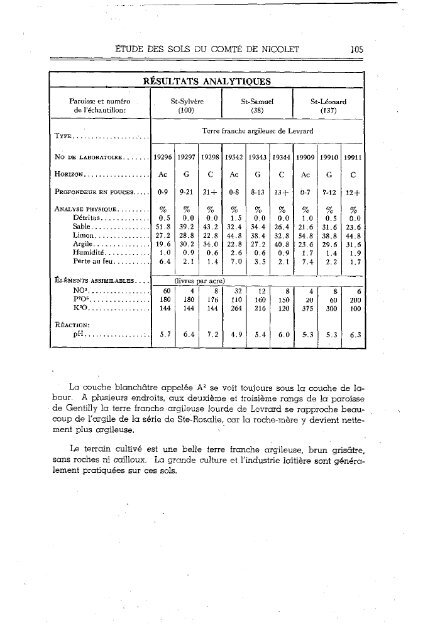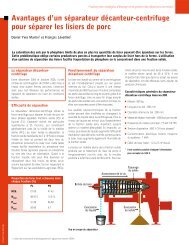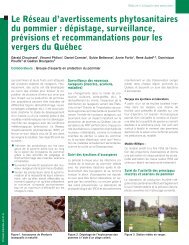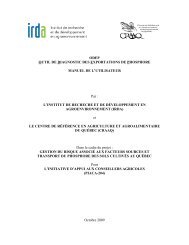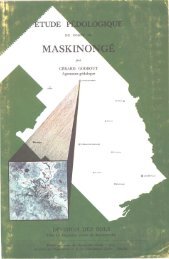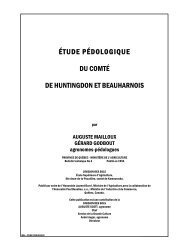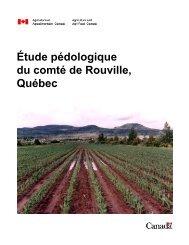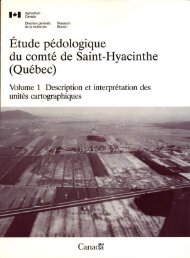PQ43 Étude des sols du comté de Nicolet - IRDA
PQ43 Étude des sols du comté de Nicolet - IRDA
PQ43 Étude des sols du comté de Nicolet - IRDA
Create successful ePaper yourself
Turn your PDF publications into a flip-book with our unique Google optimized e-Paper software.
TYPE<br />
ETUDE DES SOLS DU COMTE DE NICOLET 105<br />
RÉSULTATS ANALYTIQUES<br />
Paroisse et numéro St-Sylvere St-Samuel St-LConard<br />
<strong>de</strong> l’échantillon: W) (38)<br />
I<br />
(137)<br />
.....................<br />
Terre franche argileuse <strong>de</strong> Levrard<br />
No DE LABORATOIRE ....... 19296 19297 19298 19342 19343 19344 19909 19910 19911<br />
HORIZON .................. AC G C Ac G C Ac G C<br />
PROFONDEUREN POUCES ..... O-9 9-21 21+ O-8 a-13 13+ o-7 7-12 12+<br />
ANALYSE PHYSIQUE ......... ?JO % % % % % % '-g %<br />
Detritus. ............ 0.5 0.0 0.0 1.5 0.0 0.0 1.0 0.5 0.0<br />
Sable ................ 51.8 39.2 43.2 32.4 34.4 26.4 21.6 31.6 23.6<br />
Limon ............... 27.2 28.8 22.8 44.8 38.4 32.8 54.8 38.8 44.8<br />
Argile. .............. 19.6 30.2 34.0 22.8 27.2 40.8 23.6 29.6 31.6<br />
Humidité. ........... 1.0 0.9 0.6 2.6 0.6 0.9 1.7 1.4 1.9<br />
Perte au feu. ......... 6.4 2.1 1.4 7.0 3.5 2.1 7.4 2.2 1.7<br />
ÉLDMENTSASSIMIL.~BLES .... (livres par acre)<br />
N03. ................ 60 4 8 32 12 8 4 8 6<br />
P205 .<br />
180 180 176 110 160 150 20 60 200<br />
K20 ................................<br />
144 144 144 264 216 120 375 300 100<br />
WACTION:<br />
pH.. ............. ,:. 5.7 6.4 7.2 4.9 5.4 6.0 5.3 5.3 6.3<br />
La couche blanchâtre appelée A2 se voit toujours sous la couche <strong>de</strong> la-<br />
bour. A plusieurs endroits, aux <strong>de</strong>uxième et troisième rangs <strong>de</strong> la paroisse<br />
<strong>de</strong> Gentilly la terre franche .argileuse lour<strong>de</strong> <strong>de</strong> Levrard se rapproche beau-<br />
coup <strong>de</strong> l’argile <strong>de</strong> la série <strong>de</strong> Ste-Rosalie, car la roche-mère y <strong>de</strong>vient nette-<br />
ment plus argileuse.<br />
Le terrain cult.ivé est une belle terre franche argileuse, brun grisâtre,<br />
sans roches ni cailloux. La gran<strong>de</strong> culture et l’in<strong>du</strong>strie laitière sont généra-<br />
lement pratiquées sur ces <strong>sols</strong>.


